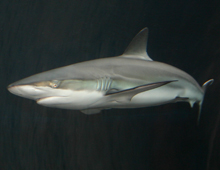Description: Known as the Brown or Sandbar shark, the common name “sandbar” comes from its habit of appearing as it crosses a sandbar, then disappearing on the other side. The upper surface is slate gray to brown; the lower surface is a paler shade of the same color or white. This species tends to have a stout body, with a short, rounded snout. The upper teeth have broadly saw-edged cusps (grinding surface of a tooth) with finely serrated edges.
Size: Average length of adult females is between seven and eight feet (2.1-2.4 m); males average six feet (1.8 m).
Behavior: They are a migratory species, with movements probably determined by water temperature changes and/or ocean currents. These sharks tend to spend most of their time near the bottom of the water column on an almost continuous search for food, but do migrate into deeper waters. Juveniles stay in their nursery areas and gather in groups until late fall when they move into deeper waters, returning to shallow waters in the summer. Brown sharks have few predators, other than humans. Shark pups are often preyed upon by other sharks. Not generally considered a threat to man; possible attacks in Hawaii have been mentioned and they should be considered potentially dangerous.
Diet: Brown sharks consume fish (including smaller sharks) and crustaceans.
Senses: Their excellent eyesight, extra sensitive sense of smell and the ability to detect vibrations and micro electrical field sent out by other animals, attribute to their super predatory skills.
Reproduction: Sexual maturity in males of this species is reached at lengths of about five feet (1.5 m) and in females at about 5.5 feet (1.68 m). Reproduction is viviparous (placental connection between the embryo and its mother) and the young are live born. Gestation varies but is most commonly from 8-12 months. The number of pups varies from 6-13 (the larger the mother, the more pups she will deliver).
Habitat/range: Found in all the world’s tropical waters (inshore and pelagic), between the surface and a depth of approximately 920 feet (280 m).
Status: They are listed by the IUCN Red List as Vulnerable. Overfishing is a concern, particularly since they are an important commercial shark species, harvested for their meat, hides, fins and livers (vitamin- rich oil).



